
Convolvulaceae, commonly called the bindweeds or morning glories, is a family of about 60 genera and more than 1,650 species. These species are primarily herbaceous vines, but also include trees, shrubs and herbs. The tubers of several species are edible, the best known of which is the sweet potato.

Lovebird is the common name for the genus Agapornis, a small group of parrots in the Old World parrot family Psittaculidae. Of the nine species in the genus, all are native to the African continent, with the grey-headed lovebird being native to the African island of Madagascar.
In ancient Greece, the Buphonia denoted a sacrificial ceremony performed at Athens as part of the Dipolieia, a religious festival held on the 14th of the midsummer month Skirophorion—in June or July—at the Acropolis. In the Buphonia a working ox was sacrificed to Zeus Polieus, Zeus protector of the city, in accordance with a very ancient custom. A group of oxen was driven forward to the altar at the highest point of the Acropolis. On the altar a sacrifice of grain had been spread by members of the family of the Kentriadae, on whom this duty devolved hereditarily. When one of the oxen began to eat, thus selecting itself for sacrifice, one of the family of the Thaulonidae advanced with an axe, slayed the ox, then immediately threw aside the axe and fled the scene of his guilt-laden crime.

The rosy-faced lovebird, also known as the rosy-collared or peach-faced lovebird, is a species of lovebird native to arid regions in southwestern Africa such as the Namib Desert. Loud and constant chirpers, these birds are very social animals and often congregate in small groups in the wild. They eat throughout the day and take frequent baths. Coloration can vary widely among populations. Plumage is identical in males and females. Lovebirds are renowned for their sleep position in which they sit side-by-side and turn their faces in towards each other. Also, females are well noted to tear raw materials into long strips, "twisty-tie" them onto their backs, and fly substantial distances back to make a nest. These birds are common in the pet industry.

The science of rosy-faced lovebird colour genetics deals with the heredity of colour variation in the feathers of the species known as Agapornis roseicollis, commonly known as the rosy-faced lovebird or peach-faced lovebird.

Myrmecophagy is a feeding behavior defined by the consumption of termites or ants, particularly as pertaining to those animal species whose diets are largely or exclusively composed of said insect types. Literally, myrmecophagy means "ant-eating" rather than "termite eating". The two habits often overlap, as both of these eusocial insect types often live in large, densely populated nests requiring similar adaptations in the animal species that exploit them.
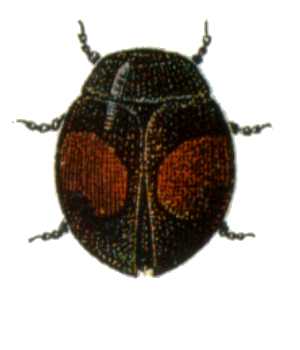
Diomus notescens, common name the minute two-spotted ladybird is a ladybird species endemic to the east and south of Australia.
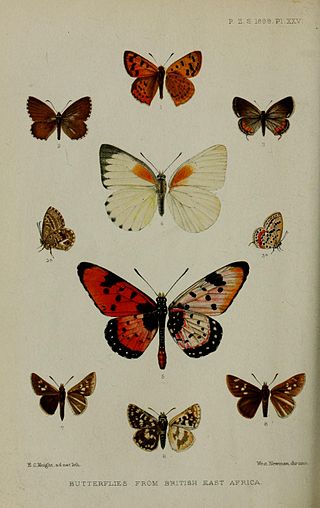
Spialia diomus, the common sandman or Diomus grizzled skipper, is a butterfly of the family Hesperiidae. It is found in tropical Africa and south-western Arabia.
Diomus pumilio is a species of ladybird. Its common name is Longblack Ladybird. It is found in North America, Oceania and Australia.
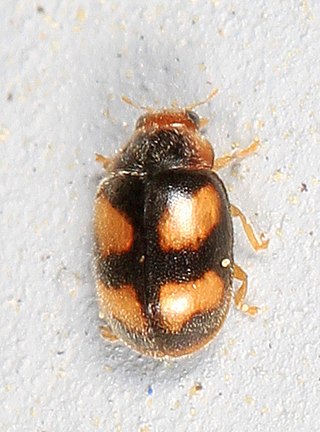
Diomus is a genus of lady beetles in the family Coccinellidae. There are at least 20 described species in Diomus.
Sphallonycha roseicollis is a species of beetle in the family Cerambycidae. It was described by Henry Walter Bates in 1866. It is known from Brazil.
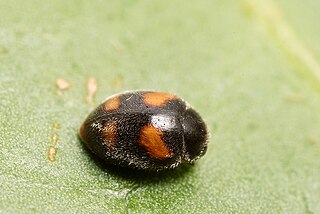
Scymninae is a subfamily of beetles in the family Coccinellidae. There are at least 170 described species in Scymninae.
Diomus pseudotaedatus is a species of lady beetle in the family Coccinellidae. It is found in North America.
Diomus bigemmeus is a species of lady beetle in the family Coccinellidae. It is found in North America.
Diomus debilis is a species of lady beetle in the family Coccinellidae. It is found in North America and Oceania.

Diomus amabilis, the amiable lady, is a species of lady beetle in the family Coccinellidae. It is found in North America.
Diomus texanus is a species of lady beetle in the family Coccinellidae. It is found in North America.
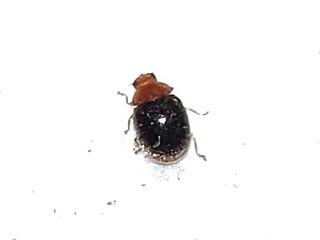
Diomus xanthaspis is a species of lady beetle in the family Coccinellidae. It is found in North America.
Diomus liebecki, or Liebeck's lady, is a species of lady beetle in the family Coccinellidae. It is found in North America.

Diomus terminatus is a species of lady beetle in the family Coccinellidae. It is found in throughout eastern North America. It is brown and oval-shaped, with a reddish tinge at the back portion of its elytra, and about 1.5 to 2 mm. It is covered in gold-colored setae, giving it a slightly hairy appearance. Its prey likely includes aphids, scale, and mealybugs.











